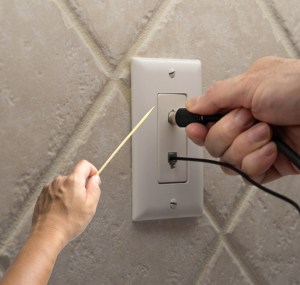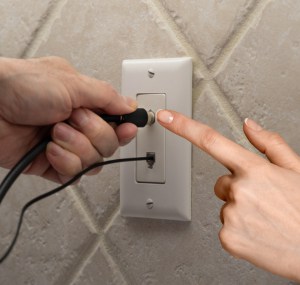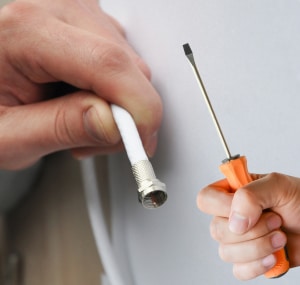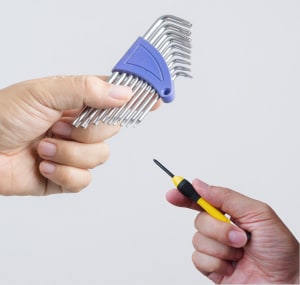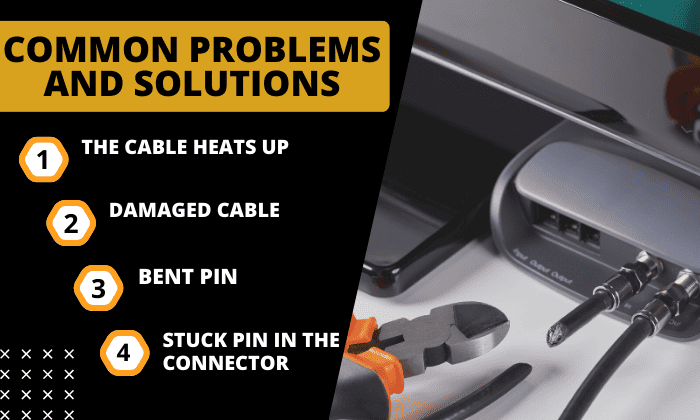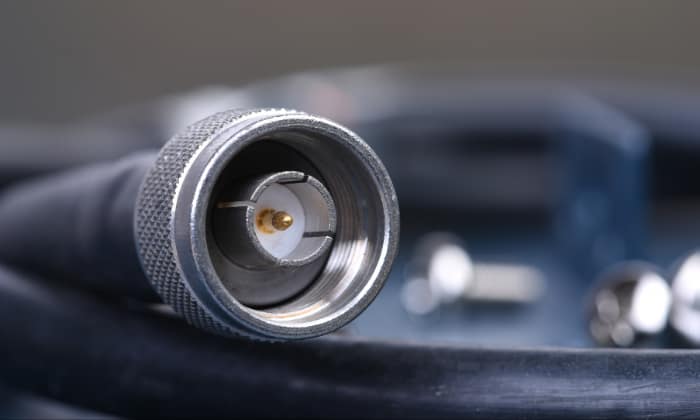Have you stayed in a hotel where the television or internet cable has a lock in its end (in the conductor)? That’s called a coaxial cable lock, which prevents the wiring from being moved, altered, or removed.
Have you ever wondered how to remove coaxial cable lock? Don’t, but to answer the question, you can do so by penetrating the gap between the cable and the lock with a rod or stick and pressing it to undo the lock. You can do so without a wrench or a pair of pliers.
Contents
What is a Coaxial Cable Lock?
The coaxial cable lock protects the coax from being removed. It’s usually seen in cables protruding from the wall in hotels, say, the cable TV or antenna. Some locks can enclose the tip of the coax, preventing unauthorized people from connecting it to anything.
It’s either metal or plastic. When you see a wire with such a lock, avoid altering it. If you need a reminder: you can be charged or fined when you remove the said lock in your accommodation.
Guide on Removing a Coax Cable Lock Without a Tool
What to prepare
- Tissue paper
- Pen cap clip or other items like a thin rod, tiny nail, metal pin, or metal stick
- Pliers or wrench
Safety considerations
Don’t force the removal, as it might scratch you, especially when undoing a metal lock. It might also damage the cable. Grab a tool for hassle-free work if you can’t defeat the lock with a do-it-yourself method.
Though a coax can’t electrocute you, it’s best to do the process when there’s no power source, so disconnect the cable before tinkering with it. However, if the cable grounds you, seek the help of an electrician.
Steps to follow:
Take note that this method is effective when undoing a plastic lock because metals are sturdier and best undone with removal tools.
Step 1: A tissue goes into the gap
Insert a tissue in the gap between the cable and the lock. It protects the cable from the pen cap clip or thin rod you will insert later and helps for smooth removal. This trick will work whether the cable is connected or not.
Step 2: Insert the apparatus in the gap
Whatever you’re using, a pen cap clip, thin rod, tiny nail, metal stick, and the like, it goes in the gap that the tissue paper penetrated first. Wedge it properly between the cable and the lock as it prevents the connector from slipping as you remove the lock.
Step 3: Press the apparatus
When the apparatus is safely wedged in the gap, firmly press its exposed part as you turn the lock clockwise or counterclockwise. Pull it when the lock loosens but don’t force it, as you might remove the coaxial cable connector or compromise the cable.
It’s important to firmly press the apparatus because it serves as an obstruction so the connector won’t slide back, and in turn, locking the cable again. When you’re having a hard time rotating the lock with your bare hands, seek the help of a pair of pliers or a wrench.
Other Methods to Consider
If you still can’t undo the lock even with the said hardware, consider the options below:
- Use a screwdriver
Some locks have small slots, which you can pry open with a flathead screwdriver or a similar tool that can penetrate the holes. Use a pair of pliers to remove the lock.
- Use an Allen wrench plus a screwdriver
Another trick to defeat a coaxial barrel lock is penetrating it with a screwdriver-Allen wrench combo. It is not always recommended because it’s too invasive and might cause damage to the cable and connector.
When the lock is jammed, twist it with a pair of pliers. To reiterate: this trick is not ideal as it might cause you headaches later on.
- Cut the cable
If the lock gets stuck and the connector is compromised, consider cutting the cable. This method is for a worst-case scenario. When doing so, use a wire cutter and not a pair of scissors, a knife, a paper cutter, or the like.
The cable is thick and will take time to split if you will not use a wire cutter. If you do this trick, it entails replacing the connector you disposed of. As such, it should be your last option – other than asking for the help of an expert with the right coaxial cable lock tool.
Types of Coaxial Cable Locks
When undoing a coax cable lock, consider its material: the metal one is harder to defeat than plastic, but both can be unlocked with the right trick.
There are variants of coax cables, which can be hard line, flexible, semi-rigid, formable, rigid, twin axial, triaxial, micro, high-frequency, high-temperature, or water-cooled.
These coaxes have differing gauges and impedance. The former pertains to the cable’s thickness, while the latter refers to the resistance of the cable to the electric current that flows through it.
Furthermore, there are many types of coaxial cable connectors that shield and connect the coax to any device.
Reasons to Remove a Coaxial Cable Lock
The only valid reason to remove a coaxial cable lock is when you own it and want it altered, like when you open a cable termination lock to check the connection.
Removing the lock is a must when it’s damaged and obstructs the connection of the cable to your devices. Also, if the wiring needs troubleshooting and/or replacement, you have no choice but to unscrew the coax cable lock.
Common Problems and Solutions
- The cable heats up
Moisture causes the cable to heat up and will affect its performance. If it’s a persistent problem, consider removing the cable trap, if there’s one, or replacing the coax. In the case of electrical shock, contact an electrician.
- Damaged cable
Aside from water or heat damage, wear and tear can contribute to a coax’s poor performance. Some tell-tale signs of such damage include protruding wires, the coating breaks off, and rusting of the connector. If said things happen, consider replacing the items.
To avoid such issues, place the coax in a secure location, away from heavy foot traffic. Ideally, you can hide them under the floor or a cable trap.
- Bent pin
The cable’s pin is not sturdy, so it’s prone to bending. To straighten it, use a pair of needle-nose pliers.
- Stuck pin in the connector
If the pin is stuck in the connector, use a pair of needle-nose pliers or tweezers to pull it. If it fails, push the pin out with a flathead screwdriver or a similar tool. Another trick is to use a heat gun to heat the connector so the pin softens before you pull it out.
If the said methods don’t work, seek the help of a professional.
Tips to Replacing Coaxial Cable Connector
As its name suggests, the connector links the cable to your devices and has many types. The most common is the F-type, a standard in cable TV, so check out the Virgin cable connector to see what it looks like.
Assuming the cable is already cut, just put the new connector by tightening it with a pair of pliers. Afterward, crimp or compress it with the respective tools, and cover it with electrical tape if needed.
Furthermore, there are different connectors, so make sure you’re working with the one compatible with your unit.
Frequently Asked Questions
Can I Reuse a Coaxial Cable Lock?
Yes, if you can ensure that it’s not damaged. The coating should be intact, its connector not rusting, and the wires are not protruding. Otherwise, use a new one for better performance.
Is it Safe to Remove a Coaxial Cable Lock?
It’s safe to tinker with the cable. However, if there’s a shock, stop what you’re doing and seek professional help. Ideally, the coax won’t cause electrocution.
How Do I Know if a Coaxial Cable Lock is Broken?
If there are protruding wires, the coating breaks off, and the connector has rust. When the coax does not have the said damage but still won’t work, troubleshoot the unit before replacing any parts.
Conclusion
Now that you know how to remove coaxial cable lock, keep in mind that you should only do so if you own the item. Never tinker with such units in hotels and public places, as they are prohibited, and there’s a risk of a fine.
One of the valid reasons to toy with your coax is when you want to remove the locking terminator of your cable TV or antenna for repair and maintenance.

Hello! I am Hart, the content writer and editor here at G0HWC. I used to be in the same local radio club with Howe, and he convinced me to join him in spreading my love for the radio with others. With a background in radio studies, I spend every day crafting accurate, easy to read content on various topics related to owning and using radios. I hope that my content can help you confidently venture in your radio journey!






